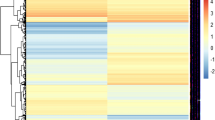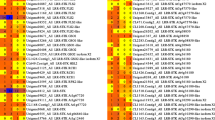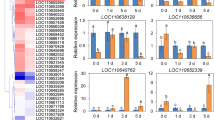Abstract
Tomato yellow leaf curl virus (TYLCV) causes tremendous losses of tomato worldwide. An elicitor Hrip1, which produced by Alternaria tenuissima, can serve as a pathogen-associated molecular patterns (PAMPs) to trigger the immune defense response in Nicotiana benthamiana. Here, we show that Hrip1 can be targeted to the extracellular space and significantly delayed the development of symptoms caused by TYLCV in tomato. In basis of RNA-seq profiling, we find that 1621 differential expression genes (DEGs) with the opposite expression patterns are enriched in plant response to biotic stress between Hrip1 treatment and TYLCV infection of tomato. Thirty-two known differential expression miRNAs with the opposite expression patterns are identified by small RNA sequencing and the target genes of these miRNAs are significantly enriched in phenylpropanoid biosynthesis, plant hormone signal transduction and peroxisome. Based on the Pearson correlation analysis, 13 negative and 21 positive correlations are observed between differential expression miRNAs and DEGs. These miRNAs, which act as a key mediator of tomato resistance to TYLCV induced by Hrip1, regulate the expression of phenylpropanoid biosynthesis and plant hormone signal transduction-related genes. Taken together, our results provide an insight into tomato resistance to TYLCV induced by PAMP at transcriptional and posttranscriptional levels.







Similar content being viewed by others
References
Abeysekara NS, Swaminathan S, Desai N, Guo L, Bhattacharyya MK (2016) The plant immunity inducer pipecolic acid accumulates in the xylem sap and leaves of soybean seedlings following Fusarium virguliforme infection. Plant Sci 243:105–114
Ahammer L, Grutsch S, Kamenik AS, Liedl KR, Tollinger M (2017) Structure of the major apple allergen Mal d 1. J Agric Food Chem 65(8):1606–1612
Alvarado V, Scholthof HB (2009) Plant responses against invasive nucleic acids: RNA silencing and its suppression by plant viral pathogens. Semin Cell Dev Biol 20(9):1032–1040
Bonnet E, He Y, Billiau K, Van de Peer Y (2010) TAPIR, a web server for the prediction of plant microRNA targets, including target mimics. Bioinformatics 26(12):1566–1568
Butterbach P, Verlaan MG, Dullemans A, Lohuis D, Visser RG, Bai Y, Kormelink R (2014) Tomato yellow leaf curl virus resistance by Ty-1 involves increased cytosine methylation of viral genomes and is compromised by cucumber mosaic virus infection. Proc Natl Acad Sci USA 111(35):12942–12947
Cle C, Hill LM, Niggeweg R, Martin CR, Guisez Y, Prinsen E, Jansen MA (2008) Modulation of chlorogenic acid biosynthesis in Solanum lycopersicum; consequences for phenolic accumulation and UV-tolerance. Phytochemistry 69(11):2149–2156
Couto D, Zipfel C (2016) Regulation of pattern recognition receptor signalling in plants. Nat Rev Immunol 16(9):537–552
Dixon RA, Achnine L, Kota P, Liu CJ, Reddy MS, Wang L (2002) The phenylpropanoid pathway and plant defence—a genomics perspective. Mol Plant Pathol 3(5):371–390
Fahlgren N, Carrington JC (2010) miRNA target prediction in plants. Methods Mol Biol 592:51–57
Gao C, Ju Z, Cao D, Zhai B, Qin G, Zhu H, Fu D, Luo Y, Zhu B (2015) MicroRNA profiling analysis throughout tomato fruit development and ripening reveals potential regulatory role of RIN on microRNAs accumulation. Plant Biotechnol J 13(3):370–382
Geng D, Shen X, Xie Y, Yang Y, Bian R, Gao Y, Li P, Sun L, Feng H, Ma F, Guan Q (2020) Regulation of phenylpropanoid biosynthesis by MdMYB88 and MdMYB124 contributes to pathogen and drought resistance in apple. Hortic Res 7(1):1–11
Gust AA, Pruitt R, Nurnberger T (2017) Sensing danger: key to activating plant immunity. Trends Plant Sci 22(9):779–791
Hartmann M, Zeier J (2018) L-lysine metabolism to N-hydroxypipecolic acid: an integral immune-activating pathway in plants. Plant J 96(1):5–21
Hollender CA, Hadiarto T, Srinivasan C, Scorza R, Dardick C (2016) A brachytic dwarfism trait (dw) in peach trees is caused by a nonsense mutation within the gibberellic acid receptor PpeGID1c. New Phytol 210(1):227–239
Hu J, Yang H, Mu J, Lu T, Peng J, Deng X, Kong Z, Bao S, Cao X, Zuo J (2017) Nitric oxide regulates protein methylation during stress responses in plants. Mol Cell 67(4):702-710.e704
Huang Y, Zhang BL, Sun S, Xing GM, Wang F, Li MY, Tian YS, Xiong AS (2016) AP2/ERF transcription factors involved in response to tomato yellow leaf curly virus in tomato. Plant Genome 9 (2):plantgenome2015.09.0082.
Jones JD, Dangl JL (2006) The plant immune system. Nature 444(7117):323–329
Kim SH, Kim YH, Ahn YO, Ahn MJ, Jeong JC, Lee HS, Kwak SS (2013) Downregulation of the lycopene epsilon-cyclase gene increases carotenoid synthesis via the beta-branch-specific pathway and enhances salt-stress tolerance in sweetpotato transgenic calli. Physiol Plant 147(4):432–442
Koo YJ, Kim MA, Kim EH, Song JT, Jung C, Moon JK, Kim JH, Seo HS, Song SI, Kim JK, Lee JS, Cheong JJ, Choi YD (2007) Overexpression of salicylic acid carboxyl methyltransferase reduces salicylic acid-mediated pathogen resistance in Arabidopsis thaliana. Plant Mol Biol 64(1–2):1–15
Kulye M, Liu H, Zhang Y, Zeng H, Yang X, Qiu D (2012) Hrip1, a novel protein elicitor from necrotrophic Fungus, Alternaria tenuissima, elicits cell death, expression of defence-related genes and systemic acquired resistance in tobacco. Plant Cell Environ 35(12):2104–2120
Langenbach C, Campe R, Schaffrath U, Goellner K, Conrath U (2013) UDP-glucosyltransferase UGT84A2/BRT1 is required for Arabidopsis nonhost resistance to the Asian soybean rust pathogen Phakopsora pachyrhizi. New Phytol 198(2):536–545
Li X, Huang L, Hong Y, Zhang Y, Liu S, Li D, Zhang H, Song F (2015) Co-silencing of tomato S-adenosylhomocysteine hydrolase genes confers increased immunity against Pseudomonas syringae pv. tomato DC3000 and enhanced tolerance to drought stress. Front Plant Sci 6:eCollection 2015
Li C, Kaituo W, Lei C, Cao S, Huang Y, Ji N, Xu F, Zheng Y (2021) Alterations in sucrose and phenylpropanoid metabolism affected by BABA-primed defense in postharvest grapes and the associated transcriptional mechanism. Mol Plant Microbe Interact 34(11):1250–1266
Lozano-Duran R, Rosas-Diaz T, Gusmaroli G, Luna AP, Taconnat L, Deng XW, Bejarano ER (2011) Geminiviruses subvert ubiquitination by altering CSN-mediated derubylation of SCF E3 ligase complexes and inhibit jasmonate signaling in Arabidopsis thaliana. Plant Cell 23(3):1014–1032
Lu H, Rate DN, Song JT, Greenberg JT (2003) ACD6, a novel ankyrin protein, is a regulator and an effector of salicylic acid signaling in the Arabidopsis defense response. Plant Cell 15(10):2408–2420
Ma Z, Song T, Zhu L, Ye W, Wang Y, Shao Y, Dong S, Zhang Z, Dou D, Zheng X, Tyler BM, Wang Y (2015) A Phytophthora sojae glycoside hydrolase 12 protein is a major virulence factor during soybean infection and is recognized as a PAMP. Plant Cell 27(7):2057–2072
Mandadi KK, Scholthof KB (2013) Plant immune responses against viruses: how does a virus cause disease? Plant Cell 25(5):1489–1505
Meng D, Li C, Park HJ, Gonzalez J, Wang J, Dandekar AM, Turgeon BG, Cheng L (2018) Sorbitol modulates resistance to Alternaria alternata by regulating the expression of an NLR resistance gene in apple. Plant Cell 30(7):1562–1581
Navarova H, Bernsdorff F, Doring AC, Zeier J (2012) Pipecolic acid, an endogenous mediator of defense amplification and priming, is a critical regulator of inducible plant immunity. Plant Cell 24(12):5123–5141
Park CH, Yeo HJ, Park YJ, Morgan AM, Valan Arasu M, Al-Dhabi NA, Park SU (2017) Influence of indole-3-acetic acid and gibberellic acid on phenylpropanoid accumulation in common buckwheat (Fagopyrum esculentum Moench) sprouts. Molecules 22(3):374
Peng XC, Qiu DW, Zeng HM, Guo LH, Yang XF, Liu Z (2015) Inducible and constitutive expression of an elicitor gene Hrip1 from Alternaria tenuissima enhances stress tolerance in Arabidopsis. Transgenic Res 24(1):135–145
Prasad A, Sharma N, Hari-Gowthem G, Muthamilarasan M, Prasad M (2020) Tomato yellow leaf curl virus: Impact, Challenges, and Management. Trends Plant Sci 25(9):897–911
Ruszkowski M, Sliwiak J, Ciesielska A, Barciszewski J, Sikorski M, Jaskolski M (2014) Specific binding of gibberellic acid by cytokinin-specific binding proteins: a new aspect of plant hormone-binding proteins with the PR-10 fold. Acta Crystallogr D Biol Crystallogr 70(7):2032–2041
Shivaprasad PV, Chen HM, Patel K, Bond DM, Santos BA, Baulcombe DC (2012) A microRNA superfamily regulates nucleotide binding site-leucine-rich repeats and other mRNAs. Plant Cell 24(3):859–874
Sun XL, Yu QY, Tang LL, Ji W, Bai X, Cai H, Liu XF, Ding XD, Zhu YM (2013) GsSRK, a G-type lectin S-receptor-like serine/threonine protein kinase, is a positive regulator of plant tolerance to salt stress. J Plant Physiol 170(5):505–515
Sunkar R, Li YF, Jagadeeswaran G (2012) Functions of microRNAs in plant stress responses. Trends Plant Sci 17(4):196–203
Vande Broek A, Gysegom P, Ona O, Hendrickx N, Prinsen E, Van Impe J, Vanderleyden J (2005) Transcriptional analysis of the Azospirillum brasilense indole-3-pyruvate decarboxylase gene and identification of a cis-acting sequence involved in auxin responsive expression. Mol Plant Microbe Interact 18(4):311–323
VanEtten HD, Mansfield JW, Bailey JA, Farmer EE (1994) Two classes of plant antibiotics: phytoalexins versus “Phytoanticipins.” Plant Cell 6(9):1191–1192
Wang Y, Zou W, Xiao Y, Cheng L, Liu Y, Gao S, Shi Z, Jiang Y, Qi M, Xu T, Li T (2018) MicroRNA1917 targets CTR4 splice variants to regulate ethylene responses in tomato. J Exp Bot 69(5):1011–1025
Wu HJ, Ma YK, Chen T, Wang M, Wang XJ (2012) PsRobot: a web-based plant small RNA meta-analysis toolbox. Nucleic Acids Res 40(W1):W22–W28
Wu J, Yang R, Yang Z, Yao S, Zhao S, Wang Y, Li P, Song X, Jin L, Zhou T, Lan Y, Xie L, Zhou X, Chu C, Qi Y, Cao X, Li Y (2017) ROS accumulation and antiviral defence control by microRNA528 in rice. Nat Plants 3(1):1–7
Xu S, Zhang X, Xu K, Wang Z, Zhou X, Jiang L, Jiang T (2022) Strawberry vein banding virus movement protein P1 interacts with light-harvesting complex II Type 1 like of fragaria vesca to promote viral infection. Front Microbiol 13:884044
Yang Y, Zhang Y, Ding P, Johnson K, Li X, Zhang Y (2012) The ankyrin-repeat transmembrane protein BDA1 functions downstream of the receptor-like protein SNC2 to regulate plant immunity. Plant Physiol 159(4):1857–1865
Yin L, Liu JX, Tao JP, Xing GM, Tan GF, Li S, Duan AQ, Ding X, Xu ZS, Xiong AS (2020) The gene encoding lycopene epsilon cyclase of celery enhanced lutein and β-carotene contents and confers increased salt tolerance in Arabidopsis. Plant Physiol Biochem 157:339–347
Zhao S, Li Y (2021) Current understanding of the interplays between host hormones and plant viral infections. PLoS Pathog 17(2):e1009242
Zorzatto C, Machado JP, Lopes KV, Nascimento KJ, Pereira WA, Brustolini OJ, Reis PA, Calil IP, Deguchi M, Sachetto-Martins G, Gouveia BC, Loriato VA, Silva MA, Silva FF, Santos AA, Chory J, Fontes EP (2015) NIK1-mediated translation suppression functions as a plant antiviral immunity mechanism. Nature 520(7549):679–682
Acknowledgements
We are grateful to Professor Xueping Zhou and Xiuling Yang (Institute of Plant Protection, Chinese Academy of Agricultural Sciences) for the generous gift of TYLCV-[CN:SH2] plasmid.
Funding
This study was supported by the National Natural Science Foundation of China (Grant No. 31701782) and the GDAS’ Project of Science and Technology Development (2021GDASYL-20210103016).
Author information
Authors and Affiliations
Contributions
YD and DQ designed the research. YD performed experiments and data analyses. YD and HZ wrote and revised the manuscript. All authors approved the manuscript.
Corresponding authors
Ethics declarations
Conflict of interest
All authors declare that there is no conflict of interest.
Supplementary Information
Below is the link to the electronic supplementary material.
Rights and permissions
Springer Nature or its licensor (e.g. a society or other partner) holds exclusive rights to this article under a publishing agreement with the author(s) or other rightsholder(s); author self-archiving of the accepted manuscript version of this article is solely governed by the terms of such publishing agreement and applicable law.
About this article
Cite this article
Dong, Y., Zhu, H. & Qiu, D. Hrip1 enhances tomato resistance to yellow leaf curl virus by manipulating the phenylpropanoid biosynthesis and plant hormone pathway. 3 Biotech 13, 11 (2023). https://doi.org/10.1007/s13205-022-03426-6
Received:
Accepted:
Published:
DOI: https://doi.org/10.1007/s13205-022-03426-6




